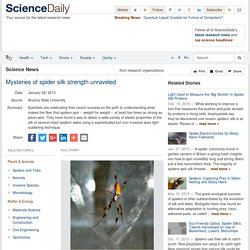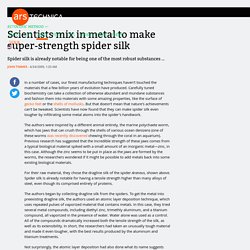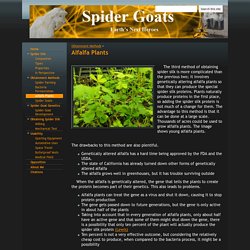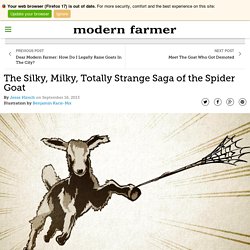

Mysteries of spider silk strength unraveled. Scientists at ASU are celebrating their recent success on the path to understanding what makes the fiber that spiders spin -- weight for weight -- at least five times as strong as piano wire.

They have found a way to obtain a wide variety of elastic properties of the silk of several intact spiders' webs using a sophisticated but non-invasive laser light scattering technique. "Spider silk has a unique combination of mechanical strength and elasticity that make it one of the toughest materials we know," said Professor Jeffery Yarger of ASU's Department of Chemistry and Biochemistry, and lead researcher of the study. Spider silk - Wikipedia. Spider silk is a protein fibre spun by spiders.

Spiders use their silk to make webs or other structures, which function as sticky nets to catch other animals, or as nests or cocoons to protect their offspring, or to wrap up prey. Mysteries of spider silk strength unraveled. Ko spider silk. Scientists mix in metal to make super-strength spider silk. In a number of cases, our finest manufacturing techniques haven't touched the materials that a few billion years of evolution have produced.

Carefully tuned biochemistry can take a collection of otherwise abundant and mundane substances and fashion them into materials with some amazing properties, like the surface of gecko feet or the shells of mollusks. But that doesn't mean that nature's achievements can't be tweaked. NSF - National Science Foundation. Alfalfa Plants - Spider Goats. The third method of obtaining spider silk is more complicated than the previous two; it involves genetically altering alfalfa plants so that they can produce the special spider silk proteins.

Plants naturally produce proteins in the first place, so adding the spider silk protein is not much of a change for them. The advantage to this method is that it can be done at a large scale. Thousands of acres could be used to grow alfalfa plants. The image shows young alfalfa plants. The drawbacks to this method are also plentiful. Genetically altered alfalfa has a hard time being approved by the FDA and the USDA. The goats with spider genes and silk in their milk. Mixing Spider DNA and Goat Embryos Produces Milk With a ... For their adorable antics and the milk they provide for delicious cheese, goats have long been among the most beloved farm residents, as well as the most common livestock on the planet.

Now, thanks to genetic engineering, some goats’ milk is being used to make more than just chèvre. When most people think of agricultural GMOs, long rows of monocropped soy liberally doused with the herbicide Roundup come to mind. Transgenic goats are bred using the same technology, but scientists believe their udders may fulfill the promise of genetic engineering by directly improving and saving lives, making everything from cancer drugs to materials for joint replacements. The animals look and act just like regular goats: Workers milk them like they would at any dairy, and the goats raid their handlers’ pockets for stuff to chew on—a risk you face around any kid, doe, or billy goat.
But scientists have added an extra protein or two to their already nutrient-rich milk. Spinning Tough Spider Silk From Goat Milk. It may be impossible to craft a silk purse from a sow's ear.

But one day, it may be possible to fashion a silk bulletproof vest from, of all things, goat's milk. For decades, scientists have been in awe of the lowly spider and the magical material it uses to spin its web. After all, strands of spider silk are a mere one-tenth the thickness of human hair, yet they can snag a bee traveling 20 miles per hour without breaking. Ounce for ounce, spider silk is five times stronger than steel and about three times tougher than man-made fibers such as Kevlar. And that makes the material ideal for all sorts of interesting uses — from better, lighter bulletproof vests to safer suspension bridges. Sci-Fi & Supernatural Videos. The Goats with Spider Genes and Silk in their Milk - Horizon: Playing God - BBC Two. Untitled. Untitled. Untitled. The Silky, Milky, Totally Strange Saga of the Spider Goat.
By Jesse Hirsch on September 16, 2013 Illustration by Benjamin Karis-Nix In the rapidly evolving field of trangenics, things have been getting weird for years.

Cabbage has been grown with scorpion venom. Mice have been bred to chirp like birds. Glow-in-the-dark kitties are real. But let’s get this out of the way: These goats can’t set webs to catch their prey, they don’t possess super-strength, and they aren’t tottering around the barn on eight bony legs (as amazing/terrifying as this would be). The milk is not for human consumption, at least not in the chèvre sense — it is meant to be refined, so the silk can be extracted and made into body armor, parachutes, fishing line and surgical sutures. The problem is, golden orb spiders aren’t the most efficient factories for their own silk — they’re too little.
A company called Nexia Biotechnologies began researching spider goats over a decade ago, dubbing their fiber BioSteel. Dr. Untitled. Untitled. The goats with spider genes and silk in their milk. Scientists breed goats that produce spider silk. (PhysOrg.com) -- Researchers from the University of Wyoming have developed a way to incorporate spiders' silk-spinning genes into goats, allowing the researchers to harvest the silk protein from the goats’ milk for a variety of applications.

For instance, due to its strength and elasticity, spider silk fiber could have several medical uses, such as for making artificial ligaments and tendons, for eye sutures, and for jaw repair. The silk could also have applications in bulletproof vests and improved car airbags. Normally, getting enough spider silk for these applications requires large numbers of spiders. However, spiders tend to be territorial, so when the researchers tried to set up spider farms, the spiders killed each other.